A Day At the Pyramids: My Giza Travel Diary
A Day At the Pyramids: My Giza Travel Diary
The Pyramids of Giza is one of those magical albeit tricky places to visit. Even after learning all the secrets or tips and tricks about a new place, sometimes you just need to hear someone else’s experience to really wrap your head around it.
What were the sights and sounds? The smells? The feelings? Was it just as magical as you have always dreamed or was it just an unfortunate tourist trap? The Pyramids of Giza is one such place, it’s also a place that I highly recommend visiting with a private guide. So allow me to take you through my A Day At the Pyramids: My Giza Travel Diary.
Pick-Up and Arrival
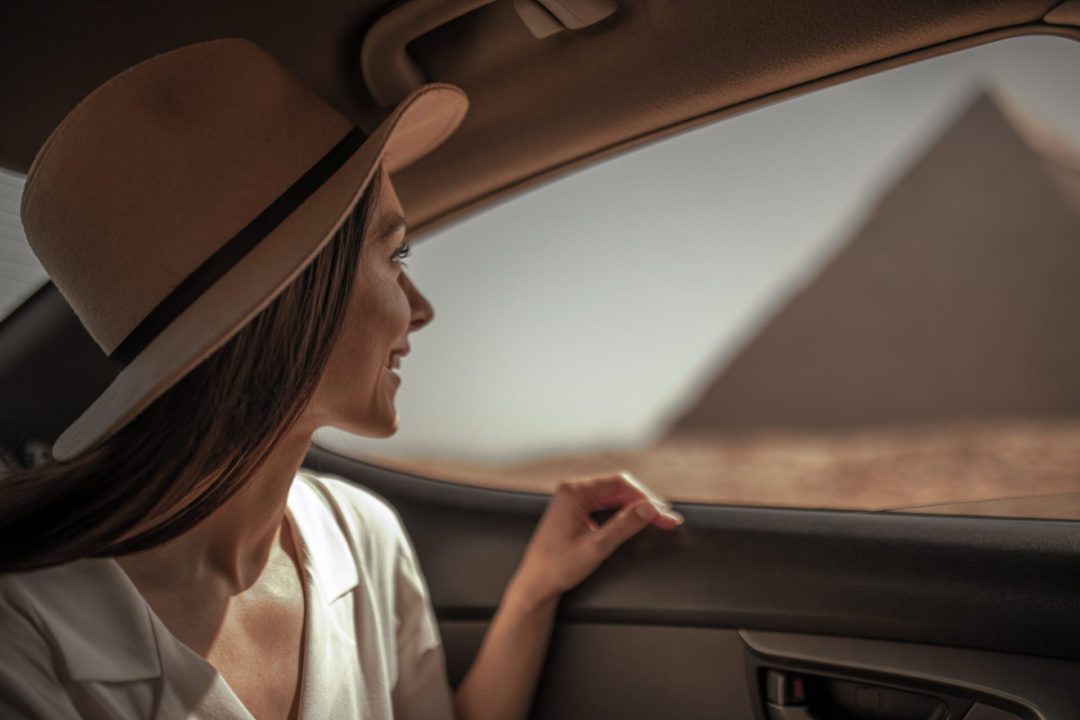
5:45AM and I was in the car with my guide and driver, making the quick journey from Marriott Mena House through the bustling streets of Giza toward the Pyramids. It’s not typical for tours to depart this early, but I wanted to take advantage of the peace and mild-temperature of the early hours. Big thank you to Memphis Tours and my guide, Reham, for accommodating!
Mena House is almost directly across from the entrance to the Plateau, so after a short stop at a drive-through security checkpoint, we were arriving at the ticket office and gated entry.
Tickets and Security
Reham, my guide, ushered us both out of the car and into the deserted entry point. While the best way to explore Giza is in an air-conditioned vehicle, all tourists are required to literally walk through security and onto the site.
General entry, which costs 200 EGP per person*, was already included in my tour, but since Giza has optional add-ons like tickets for exploring the inside the Pyramids, Reham made sure that I did not want to purchase any extras before continuing on.
Inside the gated entrance, I put my bag through an x-ray belt and walked through a metal detector – standard security measures for any of Egypt’s tourist sites. I then grabbed my bag and officially stepped onto the world famous Plateau.
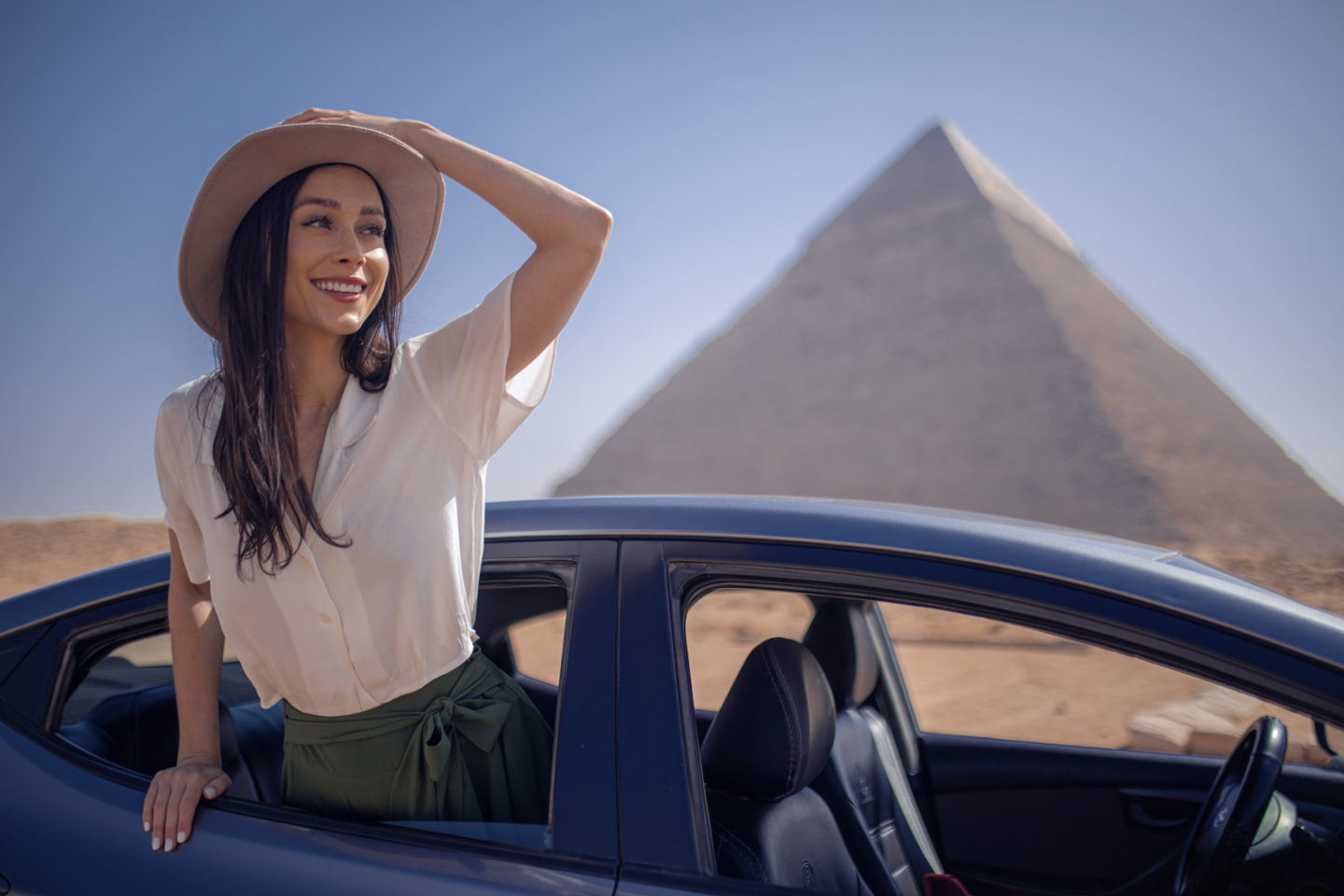
Bonus Giza Pyramids Travel Tip:
Hire an official tour guide, or at the very least a professional driver. Many of the sites and viewpoints are extremely far, and in the boiling desert heat, you will want that air conditioned vehicle.
Looking for more secret Giza tips? Don’t miss the full list in my Guide to Visiting Giza!
The Great Pyramid
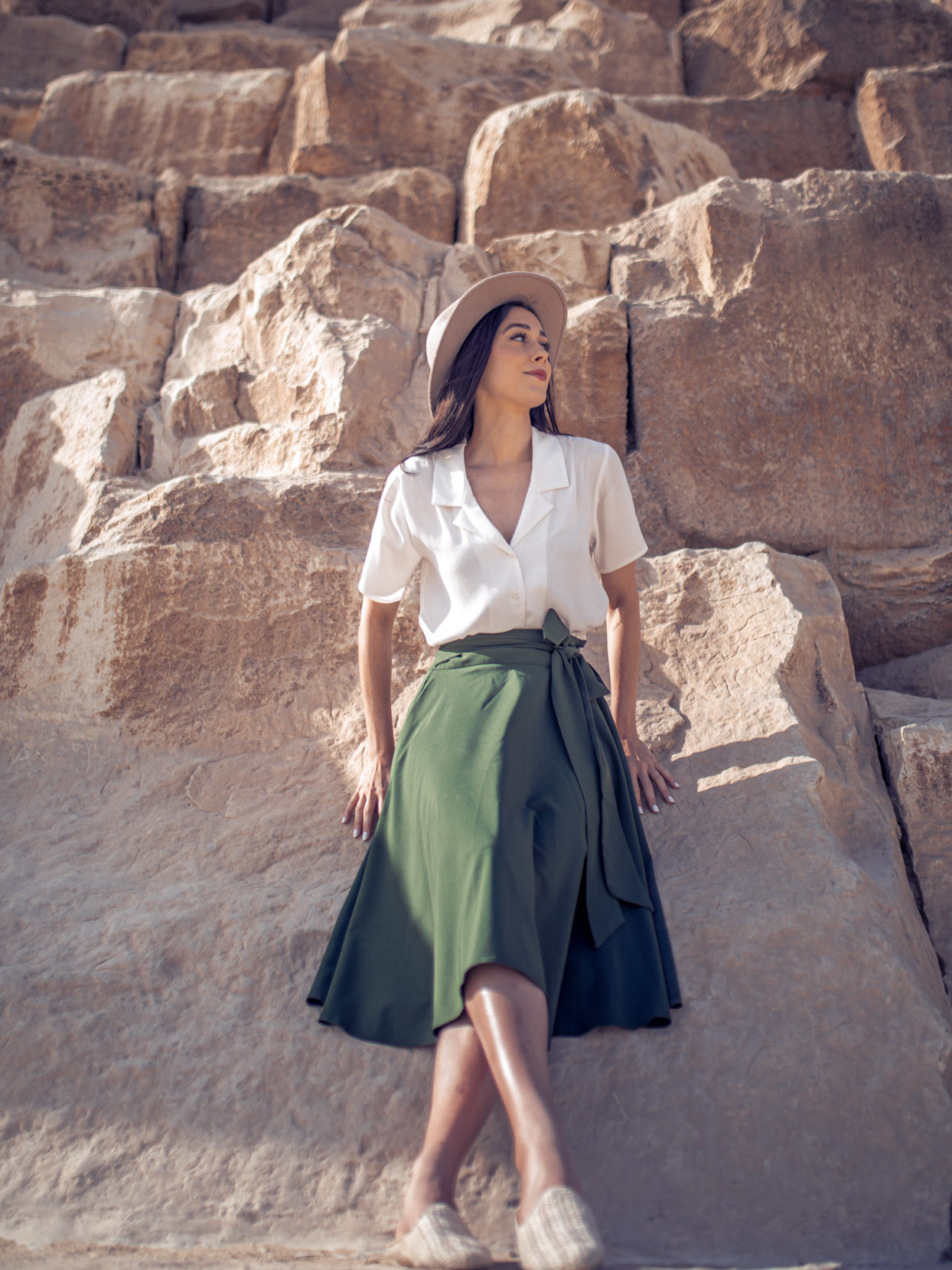
Immediately greeting me was Khufu (or Cheops), the oldest and largest Pyramid on sight. It grew – towering in front me as Reham and I drew closer and I had remind myself to pick my jaw up from the sand below.
Seeing this world famous structure up close almost completely alone was absolutely a once in a lifetime experience that I’ll never forget.
You’re typically not allowed to climb the Pyramids, but as one of the first visitors, I found a hidden and legal loophole that I otherwise might’ve missed. Each Pyramid’s tourist entrance is above ground level, meaning that there’s a clearly marked staircase running along up the side of the structure that you can climb.
I’m sure that the stairs can get crowded as the day progresses, but I took advantage of my luck and climbed the steps up for a photo-op. The immensity of each limestone brick was awe-inducing and only deepened my fascination with the ancient civilization.
The Pyramid Khafre and Mastaba Tombs
Shortly after visiting and learning the history of Khufu, Reham and I walked to the next Pyramid, Khafre. Khafre was built by the Pharaoh of the same name and who happened to be the son of the Pharaoh who build the Great Pyramid.
The Plateau was still deadly silent. Looking away from Khafre, I got my first full view of the rest of the Pyramids and the backside of the Sphinx; barely a soul in sight. I had that tingling sensation of my hair standing on edge, feeling every ounce of the breeze that swept across the plateau along with an unparalleled excitement for all I was discovering – a true main character moment.
Letting the feeling soak in, I listened as Reham explained how the Plateau is also home to a series of mastaba tombs, former resting places of ancient nobles. The short rectangular remnants of the tombs are located all around the complex, making the place look more like a former city than funerary plateau.
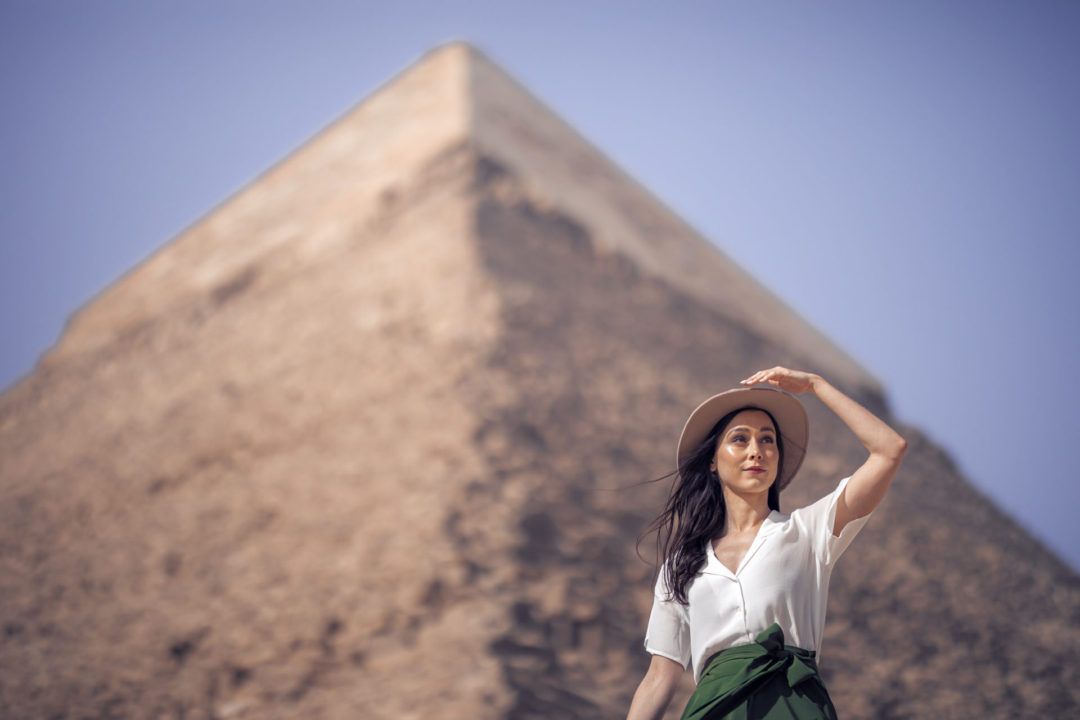
An Epic View
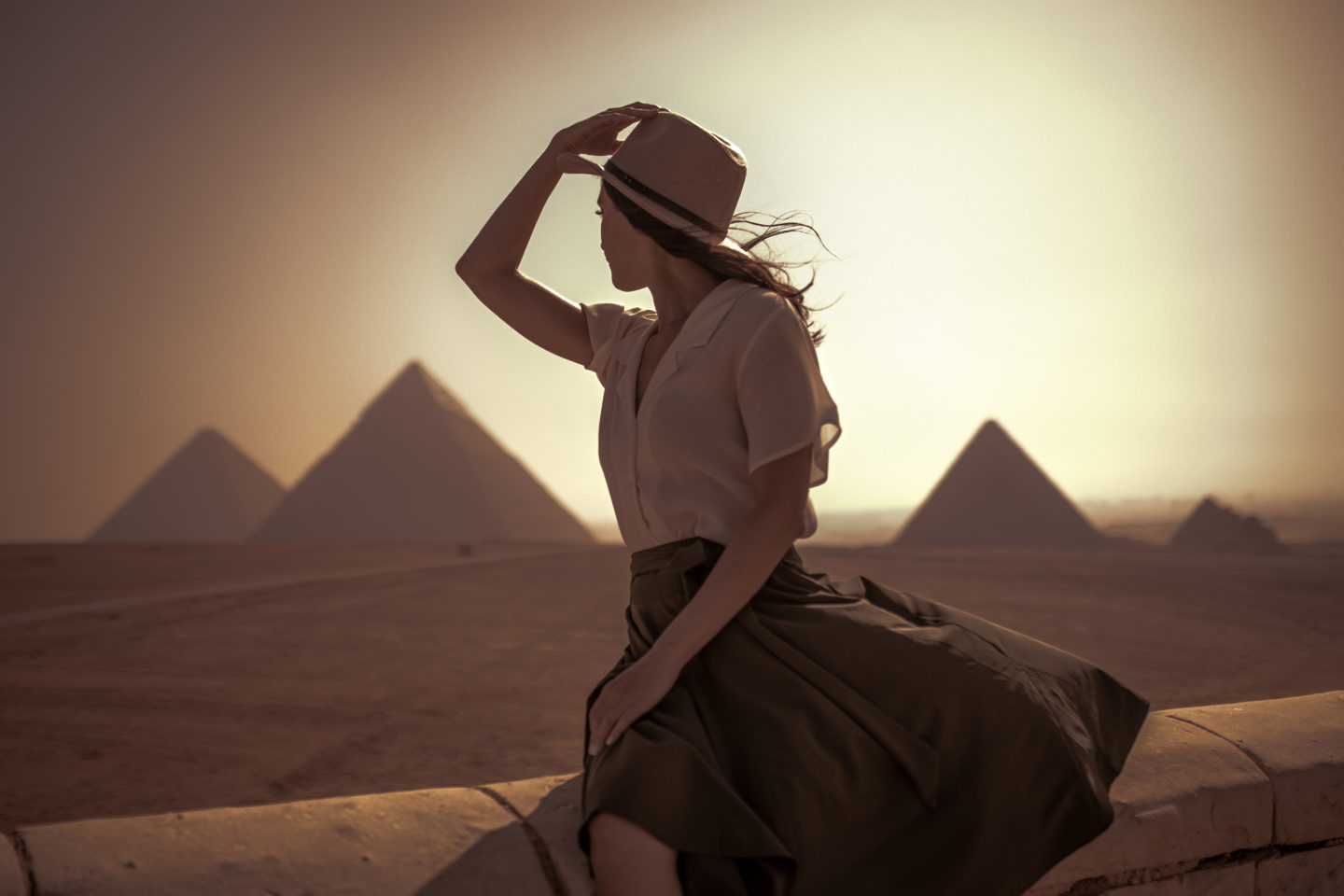
The Pyramids Panoramic viewpoint was our next stop, situated in a carpark just off of one of the complex’s main roads. It offers stunning views of the entire sight, including a peek at the three smaller, yet no less impressive, Queens’ pyramids.
There’s normally groups of chattering salesmen at the viewpoint, for both camel rides and for small trinkets, but we arrived as only a few vendors were starting to setup for the day so we were only approached with offers as we were heading back to the car for the next stop. Reham had warned me in advance that this might happen and suggested sunglasses as eye contact with sellers typically means that you are interested in buying something.
Bonus Giza Pyramids Travel Tip:
During Ramadan, Muslims fast from sunrise to sunset so fewer restaurants are open and less people are out in. the mornings. While this might limit your dining options to spots along the tourist track, it also means you’ll have a better chance to enjoy the sites sans the crowds.
If you visit during Holy Month, please note that your guide and driver are likely to be fasting and to please be respectful when stopping for your own consumption.
For my full list of secret tips and tricks for the Pyramids, check out my Guide to Visiting Giza!
No Humps in the Road
Next, we parked near the base of Menkaure, the final of the big three Pyramids and where many camel vendors set up shop. Reham turned around from the passenger seat at the front of the car and looked at me. She explained that she previously reached out to her preferred camel owners to confirm he’d be at Menkaure the morning of my visit.
Leading up to my trip, I found a lot of conflicting information about Giza camels and wanted to make sure that if I decided to ride, my experience would be as ethical as possible.
When I voiced my concerns, Reham assured me that I would be able to make a decision once we saw the situation. We quickly discussed a rate I’d feel comfortable with, knowing that if I decided to ride, she’d negotiate the price for me. If not, she’d end negotiations so I wouldn’t be hassled.
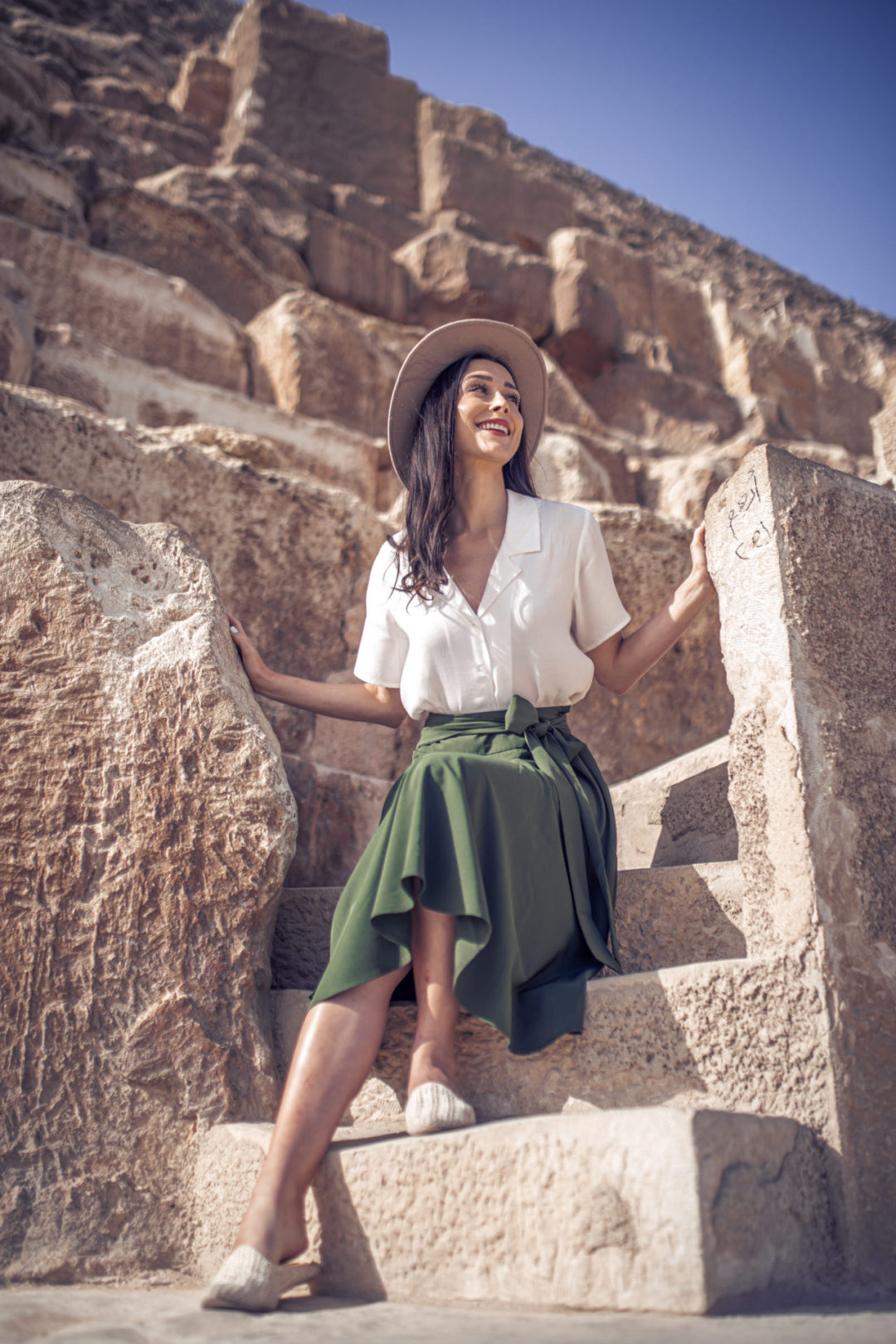
The Camels
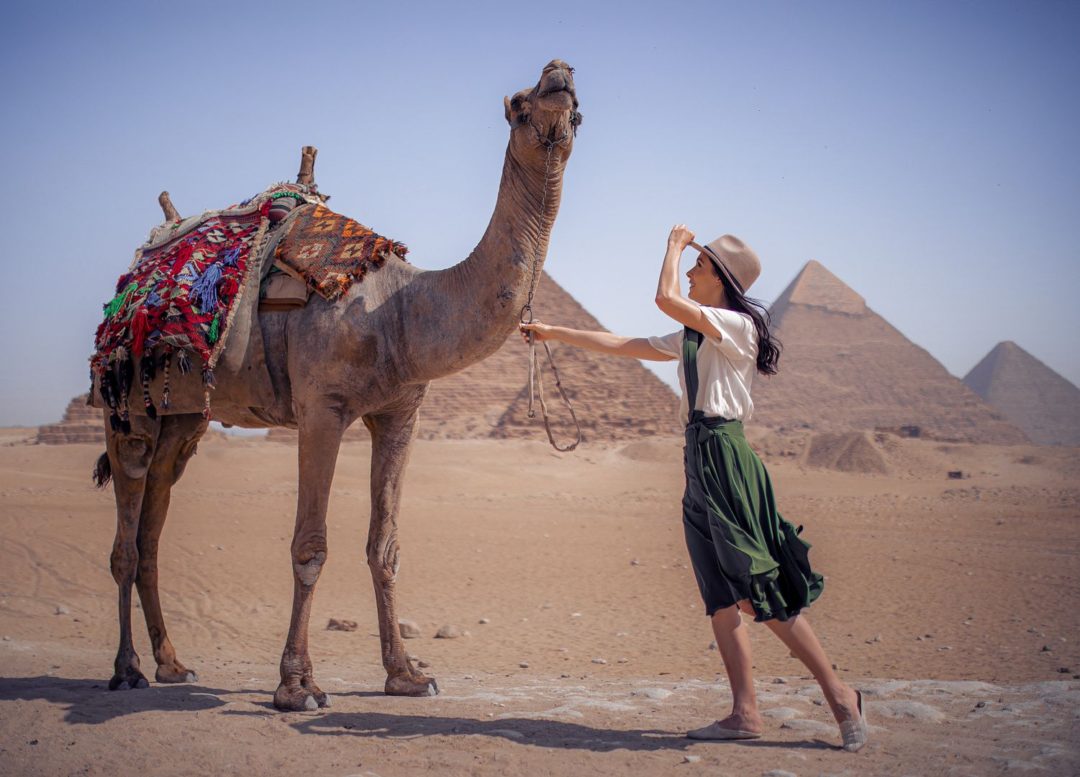
As we approached, Reham’s contact was feeding his three camels breakfast: a hearty bunch of wheat and grass. My initial observation was that they seemed relaxed. Their eyes were clear and they had no obvious cuts or bruises near their harnesses and saddles – off to a good start.
I knew from research that camels are vocal when they’re uncomfortable or don’t want to do something. But this group seemed content, quietly munching on their morning meal. The only exception, after some conversation, was when one of the three started protesting after her owner began readying her for a ride. It didn’t seem like she was quite done eating yet. Relatable, right?
I ultimately decided to proceed when instead of pushing things, the owner mumbled “Temem, temem” (“OK, OK”) and left her to it before moving to the other camels who had just finished eating.
Important Caveats and Moral Dilemmas
I was extremely lucky to find that the three camels I saw at Giza were well taken care of. However, please know this won’t always be the case and that my experience on this one occasion could be vastly different from someone else’s. It would have been much easier for me to avoid the camels at Giza completely, but unfortunately the issue isn’t black-and-white:
Egypt is a country that relies heavily on tourism for income. And while I’m by no means an expert, tourist numbers have sharply declined this last decade due to a variety of factors, causing lots of economic uncertainty for the country.
For many, offering activities like camel rides is the very thing helping them feed their families. If enough tourists decided to not endorse camel rides, the financial repercussions would be extreme. These same families would most likely need to find an alternate use for their animals to secure an income, of which, the easiest and most well-known way is by trading at Cairo’s Birqash camel market, a known hot spot for animal cruelty.
If there’s anything I’ve learned through traveling, it’s to always approach situations with an open mind and trust your gut to determine the best way forward.
Here, I do believe the answer lies in reform, rather than avoidance. So if you’re visiting Giza, see something you disagree with and can safely speak out, please do so. Your voice matters and could be the very thing that helps ensure more sustainable and humane animal practices for years to come.
The Ride
The ride itself was a quick 30 minutes. My camel and I started out from Menkaure and rode slightly south; past the Pyramids of the Queens. About 10 minutes later, we had stopped midway between the Pyramids of the Queens and the 9 Pyramids Lounge.
We stayed there for a bit, enjoying the view before making our way back to our starting point. The most interesting part of the experience was getting on and off my camel – a true balancing act and probably very entertaining for anyone watching.
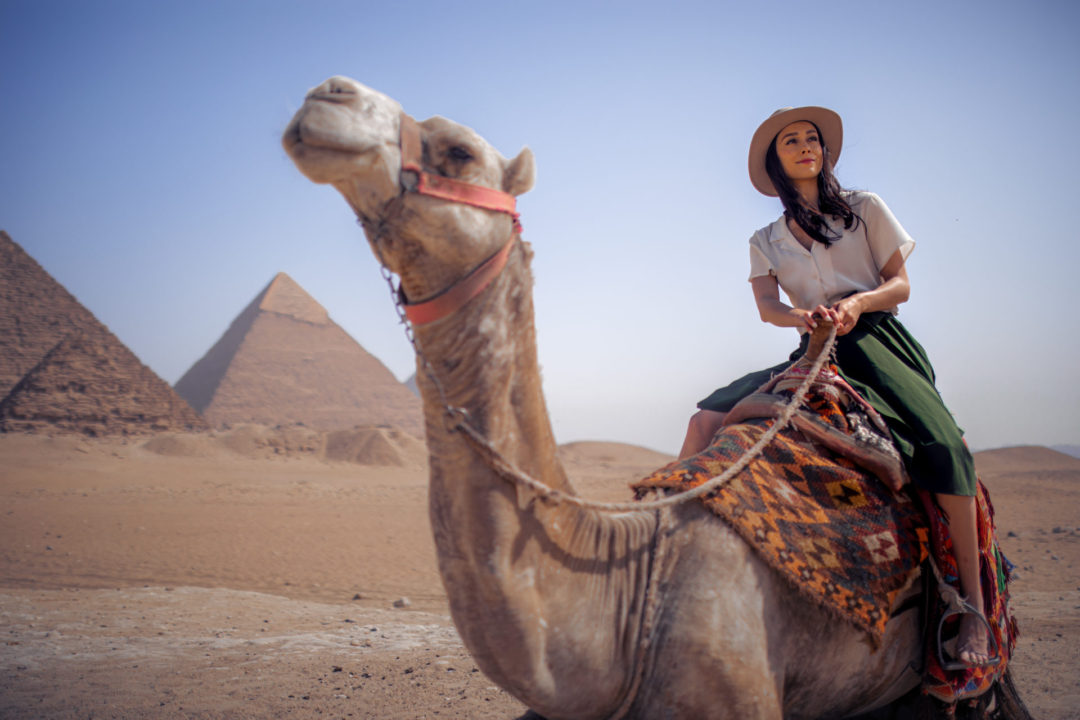
Bonus Giza Pyramids Travel Tip:
It was starting to heat up as our caravan of camels made its way back to the Menkaure Pyramid starting point, so if you find a solid option for a camel excursion, I highly suggest going as early as possible or as close to sunset as possible, when the weather is cooler.
It will be more enjoyable for your camel and for you!
Final Stop: The Great Sphinx
After the camels, we hopped back in the car and drove through the center of the Plateau, until we were close to the front of the Sphinx. Our driver stopped in the middle the road where Reham and I got out and hopped over a curved stone barrier that separated us and the large monolith.
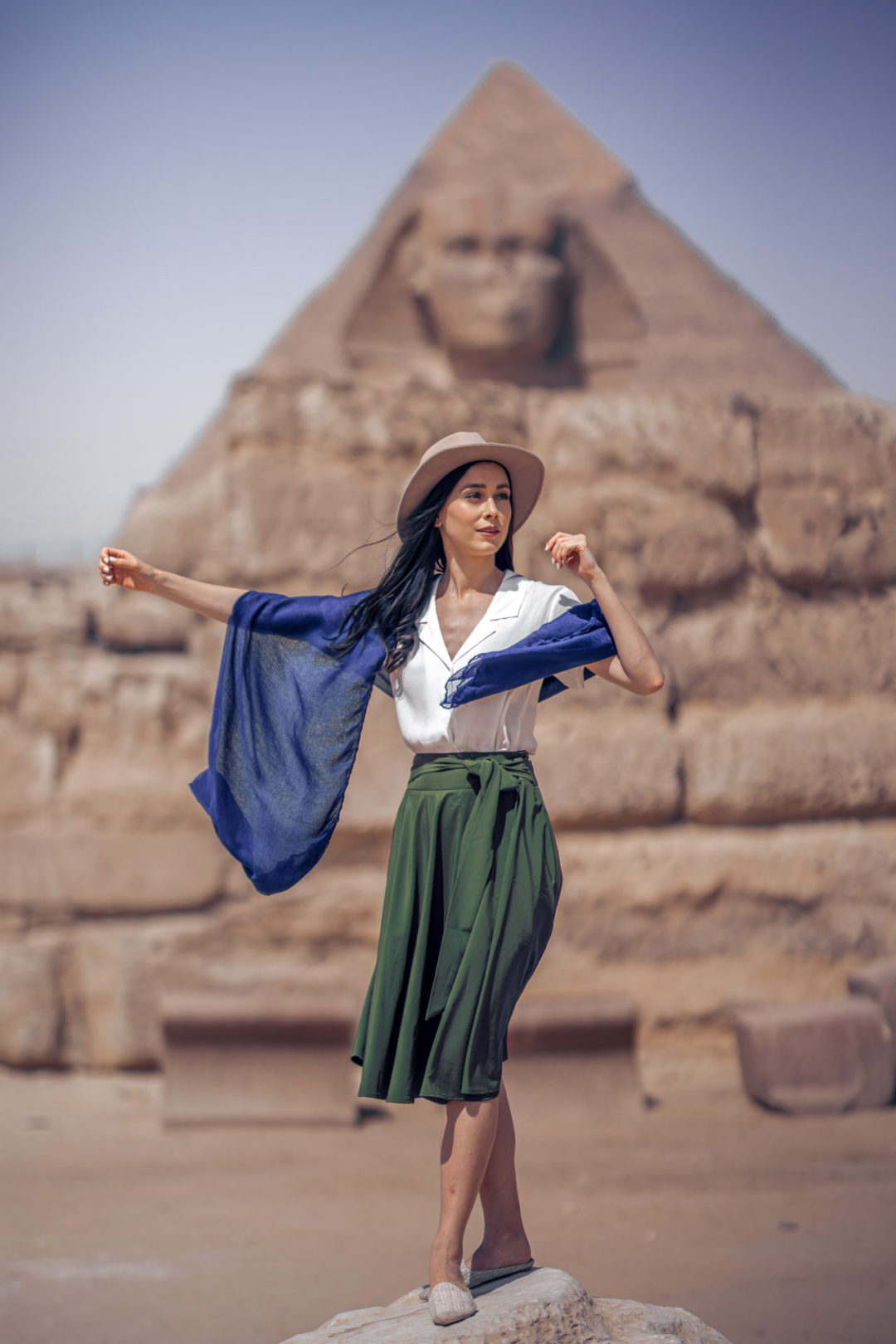
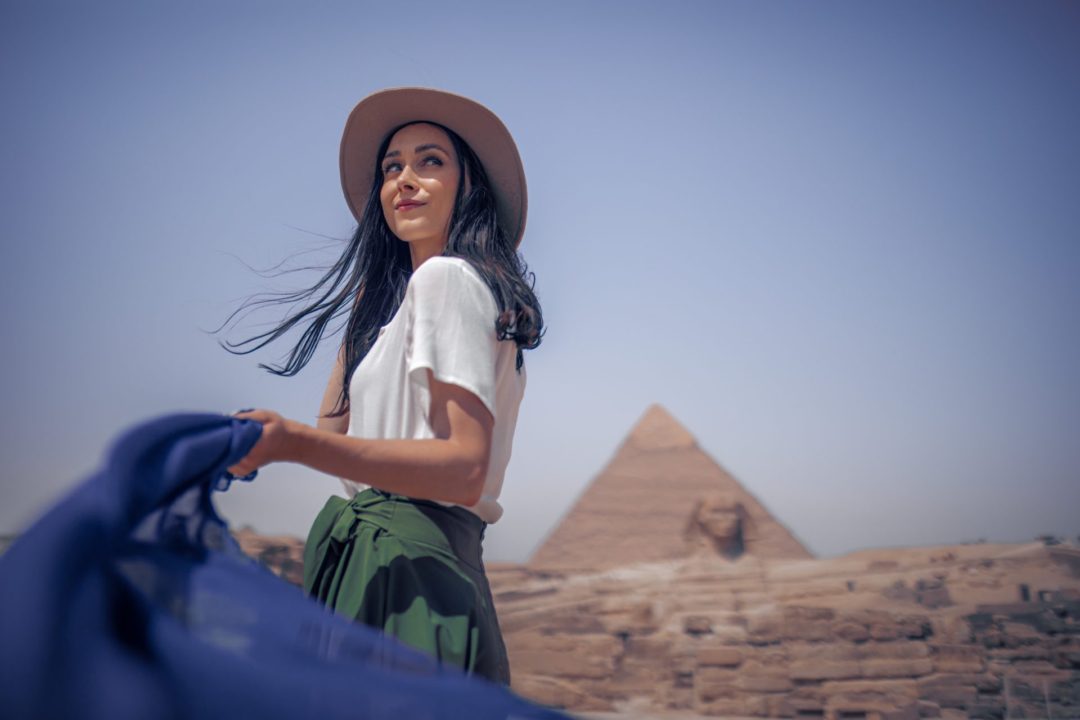
Next thing I knew, a policeman was in our faces, his thundering voice telling us it was illegal to hop over the 3 foot wall… Only, it wasn’t. Reham, who had crossed this exact way many times before, sprung into action, communicating with the policeman. After a few minutes of back-and-forth, he went on his way, no questions asked and no “hush money” paid. And we went on ours, edging even closer to the marred, yet no less impressive giant.
It was at this point, that the inevitable hoard of tourists had finally begun to show up. While most groups began at the Pyramids proper, from where we had just come, a select few groups started their day at the Sphinx and attached Funerary Temple near its foot.
Luckily, Reham knew I was just as interested in the history as I was with staying away from the crowds. She led me to the a lone dirt stretch right in front of the statue, holding nothing except for a few large rocks. While the groups were going directly into the Funerary Temple and onwards to the side of the Sphinx, we were still able to go over the history and nab our photos just in front without anyone else in frame.
We spent 15 minutes there before, finally, braving the crowds at The Funerary Temple.
I’ll be honest, at this point in my journey, I’d seen so many ancient places that the Sphinx’s Funerary Temple didn’t seem like anything out of the ordinary, especially with all the other people around. That said, the Temple does have one big eye opening factor: the exit. When you take the short walk up from the temple up toward the exit, you’re greated with the most breathtaking close-up view of the Sphinx.
The Funerary Temple was the perfect place to end the tour and not only because it includes a *very rare* opportunity for shade during the middle of the day, but also because it still gives visitors a rare look into the magic of the past.
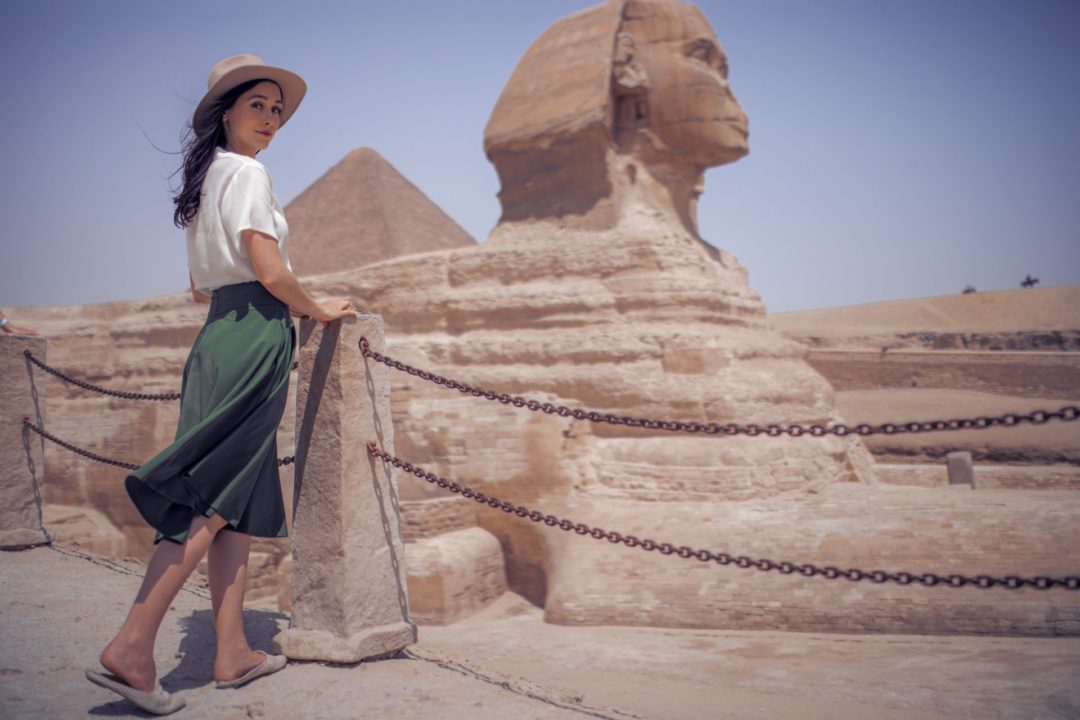
Thinking of visiting the Pyramids yourself? Don’t miss my list of insider tips in the Guide to Giza!
*All entry costs shown above are correct at time of writing and may be subject to change.
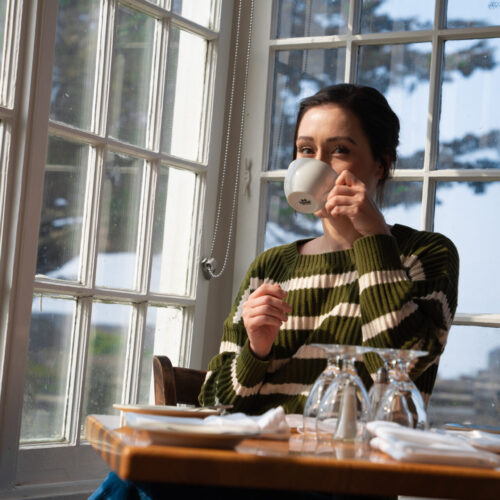 A Fragrant Welcome: My First Day in Mendocino and Fort Bragg
A Fragrant Welcome: My First Day in Mendocino and Fort Bragg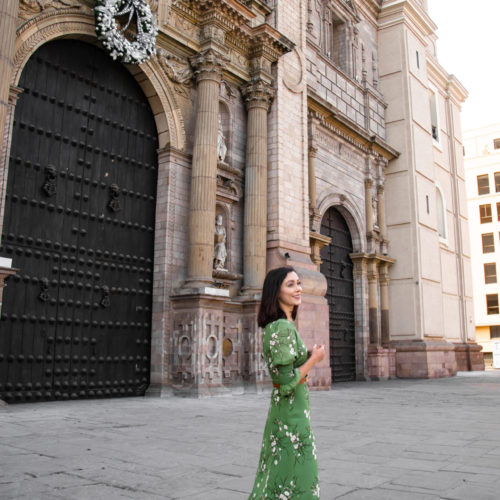 7 Tips for How To Survive Traveling Solo over the Holidays
7 Tips for How To Survive Traveling Solo over the Holidays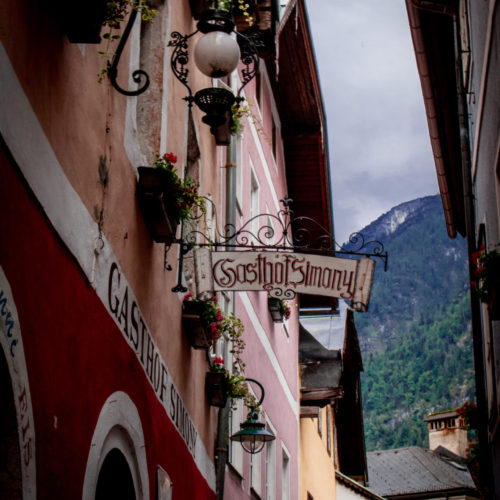 1 Magical Day in Hallstatt: How To Avoid The Crowds
1 Magical Day in Hallstatt: How To Avoid The Crowds
